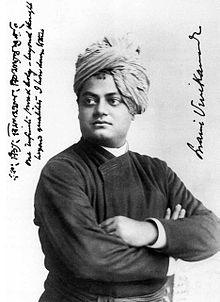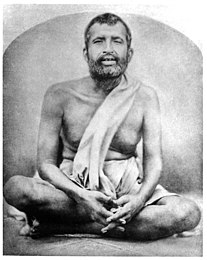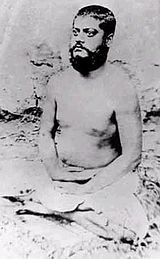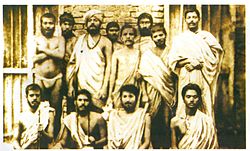With Ramakrishna
In 1881 Narendra first met Ramakrishna, who became his spiritual focus after his own father had died in 1884.
Narendra’s first introduction to Ramakrishna occurred in a literature class at General Assembly’s Institution when he heard Professor William Hastie lecturing on William Wordsworth’s poem, The Excursion. While explaining the word “trance” in the poem, Hastie suggested that his students visit Ramakrishna of Dakshineswar to understand the true meaning of trance. This prompted some of his students (including Narendra) to visit Ramakrishna.
They probably first met personally in November 1881, though Narendra did not consider this their first meeting, and neither man mentioned this meeting later. At this time Narendra was preparing for his upcoming F. A. examination, when Ram Chandra Datta accompanied him to Surendra Nath Mitra’s, house where Ramakrishna was invited to deliver a lecture. According to Paranjape, at this meeting Ramakrishna asked young Narendra to sing. Impressed by his singing talent, he asked Narendra to come to Dakshineshwar.
In late 1881 or early 1882, Narendra went to Dakshineswar with two friends and met Ramakrishna. This meeting proved to be a turning point in his life. Although he did not initially accept Ramakrishna as his teacher and rebelled against his ideas, he was attracted by his personality and began to frequently visit him at Dakshineswar. He initially saw Ramakrishna’s ecstasies and visions as “mere figments of imagination” and “hallucinations”. As a member of Brahmo Samaj, he opposed idol worship, polytheism and Ramakrishna’s worship of Kali. He even rejected the Advaita Vedanta of “identity with the absolute” as blasphemy and madness, and often ridiculed the idea. Narendra tested Ramakrishna, who faced his arguments patiently: “Try to see the truth from all angles”, he replied.
Narendra’s father’s sudden death in 1884 left the family bankrupt; creditors began demanding the repayment of loans, and relatives threatened to evict the family from their ancestral home. Narendra, once a son of a well-to-do family, became one of the poorest students in his college. He unsuccessfully tried to find work and questioned God’s existence, but found solace in Ramakrishna and his visits to Dakshineswar increased.
One day Narendra requested Ramakrishna to pray to goddess Kali for their family’s financial welfare. Ramakrishna suggested him to go to the temple himself and pray. Following Ramakrishna’s suggestion, he went to the temple thrice, but failed to pray for any kind of worldly necessities and ultimately prayed for true knowledge and devotion from the goddess. Narendra gradually grew ready to renounce everything for the sake of realising God, and accepted Ramakrishna as his Guru.
In 1885, Ramakrishna developed throat cancer, and was transferred to Calcutta and (later) to a garden house in Cossipore. Narendra and Ramakrishna’s other disciples took care of him during his last days, and Narendra’s spiritual education continued. At Cossipore, he experienced Nirvikalpa samadhi. Narendra and several other disciples received ochre robes from Ramakrishna, forming his first monastic order. He was taught that service to men was the most effective worship of God. Ramakrishna asked him to care for the other monastic disciples, and in turn asked them to see Narendra as their leader. Ramakrishna died in the early-morning hours of 16 August 1886 in Cossipore.




